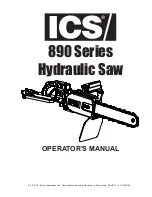
8
9
b) Wear personal protective gear and always wear safety
glasses. Protective equipment such as dust mask, non-
skid safety shoes, hard hat, or hearing protection used
for appropriate conditions will reduce personal injuries.
c) Avoid accidentally activating the device. Make sure
that the power tool is turned off before you connect it to
the power supply and/or the rechargeable battery, pick it
up or carry it. Carrying power tools with your finger on the
switch or connecting the power tool to a power supply
while the switch is set to “on” may lead to accidents.
d) Remove all adjusting tools or spanners before you
switch the power tool on. A wrench or a key left attached
to a rotating part of the power tool may result in personal
injury.
e) Avoid an abnormal posture. Keep proper footing and
balance at all times. This enables better control of the
power tool in unexpected situations.
f) Wear suitable clothing. Do not wear loose clothing or
jewellery. Keep your hair and clothing away from moving
parts. Loose clothes, jewellery or long hair can be caught
in moving parts.
g) If there is an option for installing dust suction devices
and dust containers, these should be attached and used
correctly. Use of dust collection can reduce dust-related
hazards.
h) Do not be lulled into a false sense of security and
ignore the safety rules for power tools, even if you are
well acquainted with power tools, having used them
frequently. Using power tools without due care and
attention can cause serious injuries in a split second.
GENERAL SAFETY WARNINGS
GENERAL SAFETY WARNINGS
Using and handling the power tool
a) Do not overload the power tool. Use the right power
tool for your work. The correct power tool will do the job
better and safer at the rate for which it was designed.
b) Do not use a power tool if its switch is defective. Any
power tool that cannot be controlled with the switch is
dangerous and must be repaired.
c) Disconnect the plug from the power source and/or
remove the rechargeable battery from the power tool
before making any adjustments, changing insertion
tools or storing the power tool. Such preventive safety
measures reduce the risk of starting the power tool
accidentally.
d) Keep unused power tools out of the reach of children.
Do not let any individual who is not familiar with the
power tool or who has not read these instructions operate
this power tool. Power tools are dangerous in the hands
of untrained users.
e) Maintain power tools and insertion tools with care.
Check to make sure that the moving parts are functioning
properly and not stuck, whether parts are broken or
damaged so as to affect the function of the power tool.
If any parts of the power tool are damaged, have them
repaired before use. Many accidents are caused by
poorly maintained power tools.
f) Keep cutting tools sharp and clean. Properly maintained
cutting tools with sharp cutting edges are less likely to
bind and are easier to control.
g) Use the power tool and insertion tools, etc., in
accordance with these instructions. At the same time,


































